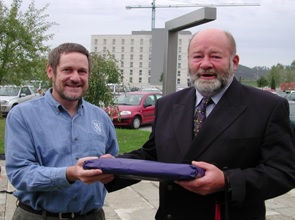Rural Round-up : the John Macleod Oration 2014
Improving the Health of Rural People through Health Workforce Policy - by Roger Strasser
 Dr John Macleod (pictured) was a rural family doctor and founding member of the WONCA Working Party on Rural Practice. John and his parents before him provided family medicine care to the people of Hebridean island of North Uist for 77 years. To honour his outstanding contribution to rural health, the WONCA Working Party on Rural Practice initiated the John Macleod Oration as a feature plenary address at WONCA World Rural Health Conferences. This edition of Rural Round-up is based on the 2014 John Macleod Oration which was delivered by Professor Roger Strasser at the 2014 WONCA World Rural Health Conference in Gramado, Brazil.
Dr John Macleod (pictured) was a rural family doctor and founding member of the WONCA Working Party on Rural Practice. John and his parents before him provided family medicine care to the people of Hebridean island of North Uist for 77 years. To honour his outstanding contribution to rural health, the WONCA Working Party on Rural Practice initiated the John Macleod Oration as a feature plenary address at WONCA World Rural Health Conferences. This edition of Rural Round-up is based on the 2014 John Macleod Oration which was delivered by Professor Roger Strasser at the 2014 WONCA World Rural Health Conference in Gramado, Brazil.
This article explores the role of health workforce policy in improving the health of rural people. After presenting the rural health context, there is a description of key initiatives which enhance rural health workforce followed by an introduction to the Northern Ontario School of Medicine (NOSM) in Canada, an example of education and training initiatives which strengthen the rural health workforce.

Policy is a high level overall plan often specified by government which outlines acceptable procedures aimed at achieving general goals. In the context of “evidence based medicine”, there is often an expectation amongst doctors that there should be “evidence based policy”. Frequently however, political leaders are guided by the evidence of public opinion and/or adopt policy ideas before looking for evidence to justify their ideas.
Photo: a younger Roger Strasser with John Macleod
There are a series of key parameters that provide the framework which determines the structure and function of rural health services, how rural practitioners work and the nature of rural practice. These “rural realities” are the physical environment, the rural culture, the patterns of health status, illness and injury, and availability of resources and personnel. Despite substantial differences between developing and developed countries, access is the major rural health issue around the world. Even in the countries where the majority of the population lives in rural areas, the resources are concentrated in the cities. All countries have transport and communication difficulties between rural and urban communities, and they all face the challenge of shortages of doctors and other health professionals in remote rural areas.
When compared to their metropolitan counterparts, rural practitioners provide a wider range of services and carry a higher level of clinical responsibility in relative professional isolation. Living in the community they serve, rural practitioners also have a specific community health role with the opportunity to influence the health of the community as a whole, as well as through individual patient and family interactions. As a general statement, interprofessional collaboration is common in rural communities with insufficient numbers of healthcare providers working together to respond to community needs. In this context, the most effective rural health service models are those developed in rural communities for rural communities with the doctors and other health professionals providing all local health services supported by distant specialist services.
It is the common experience in rural communities that policies are developed to address issues of large population centres without any consideration of implications or potential negative consequences for small rural communities. Recognising this phenomenon, the Commission for Rural Communities in Great Britain developed a mechanism for assessing potential policies known as “rural proofing”. This approach recommends that rural communities engage in policy development at an early stage supported by strong and robust data. It is recommended also that health professionals develop partnerships at local, regional and national levels with the potential for multi-sector networks.
Focusing specifically on rural health workforce, the
WONCA Working Party on Rural Practice has provided global leadership since 1995 in developing and promulgating WONCA rural policies. In fact, it was not until 2008 that the World Health Organisation (WHO) initiated the first Global Forum on Human Resources for Health. The 2002 WONCA Rural Health Conference adopted the “
Melbourne Manifesto: a code of practice for international recruitment of health care professionals” which was followed in 2010 by the WHO Global Code of Practice on the International Recruitment of Health Personnel.
Also in 2010, the WHO released Global Policy Recommendations on “increasing access to health workers in remote and rural areas through improved retention”. The four key headings in this document are: education and training; regulatory initiatives; financial incentives and reward; and personal and professional support. Subsequently, I have come to the view that a fifth item is sustainable service models. Health services in small rural communities achieve sustainability through strong collaboration involving: the health service authority/agency; local healthcare providers; and active community participation.
The three factors most strongly associated with recruitment into rural practice are: a rural upbringing; positive rural educational and clinical experiences during undergraduate medical education; and targeted postgraduate training for rural practice. Key retention factors include: academic involvement (education and research); recognition and reward for rural practitioners; support from the health service system; and active community engagement.
Northern Ontario is a vast rural region of Canada which has a volatile resource based economy. The health status of people in the region is worse than Ontario as a whole and there is a chronic shortage of doctors and other health professionals. NOSM opened in 2005 with a social accountability mandate to contribute to improving the health of the people and communities of Northern Ontario. Uniquely developed through a community consultative process, the holistic cohesive curriculum for the NOSM undergraduate program is set in the Northern Ontario health context, relies heavily on electronic communications and on community partnerships to support Distributed Community Engaged Learning. In the cla

ssroom and in clinical settings, students explore cases from the perspective of doctors practising in Northern Ontario. There is a strong emphasis on interprofessional education and integrated clinical learning which takes place in over 90 communities and many different health service settings, so that the students have personal experience of the diversity of the region’s communities and cultures.
After seven years of recruiting applicants from its underserved health workforce region, there are signs that NOSM is successful in graduating health professionals who have the skills and the desire to provide healthcare in remote rural communities.
Prof Roger Strasser (pictured)